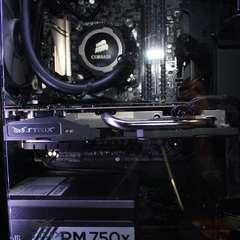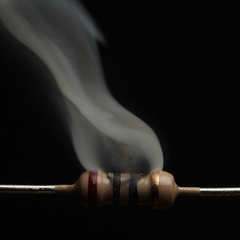
Factory Factory
-
Posts
62 -
Joined
-
Last visited
Reputation Activity
-
 Factory Factory got a reaction from yuh25 in Alienware no longer shipping high end gaming PCs to certain US States, citing new power consumption regulations
Factory Factory got a reaction from yuh25 in Alienware no longer shipping high end gaming PCs to certain US States, citing new power consumption regulations
Okay there's a LOT of FUD in the coverage. I'm a paralegal and I did a deep dive of the regulations, specifically 20 CCR secs. 1605, 1604, 1602, and the Energy Star testing methodology.
tl;dr: The only reason the regs give that might block these particular Alienware systems is that their ACPI S3 Sleep state power consumption is over 10W from the wall. On a system that can have a 1000W power supply, that's actually not very surprising. It's hard to make big PSUs efficient at small loads. ATX12VO will help this in the long run.
So, about the regs and what they actually mean:
First, the yearly power consumption is not measured at load. The Energy Star methodology the regs refer to is a weighted average: yearly power consumption if the system is 55% turned off, 5% in sleep mode, and 40% idling at desktop. Load power consumption is not part of that power budget; it's all about idle-or-less power efficiency. When you include the beefy add-ons to the power budget for a discrete GPU, it's actually pretty easy for a modern machine, even DIY, to hit the power target.
E: Note: The regs specify Energy Star for computers 6.0. The current version is 8.0 and distinguishes more for short idle and long idle power draws.
The biggest crunches will probably be mini-ITX gaming machines with limited ports, since ports are how expandability score is measured and more expandability = more power budget. But even so you'd need a comically small number of user-accessible internal and external ports (like base tier M1 iMac small) to hit the most stringent limits and be seriously threatened by a typical 65W desktop idle.
Second, "high expandability" machines are exempted from the yearly consumption altogether, like workstations. A high expandability machine is one that either has a shitload of ports (there's a table in 20 CCR 1604), or it has a 600W+ PSU and a GPU with 600 GB/s of VRAM bandwidth (20 CCR 1602).
These machines' only requirements are:
Use an 80+ Gold or better PSU (for internal PSUs) ACPI S3 Sleep state power draw is 10W at the wall or less, plus 0.15W per GB of RAM over 32 If it's shipped with an OS installed, power management is configured to turn off the screen after 15 minutes and enter S3 sleep after 30 minutes
Third, DIY is definitely not affected. Small-run boutique builds under 50 units have the same requirements as the high-expandability/workstation requirements above. If you want to sell a build to a friend, that won't make you an energy criminal in California.
-
 Factory Factory got a reaction from Hairless Monkey Boy in Alienware no longer shipping high end gaming PCs to certain US States, citing new power consumption regulations
Factory Factory got a reaction from Hairless Monkey Boy in Alienware no longer shipping high end gaming PCs to certain US States, citing new power consumption regulations
Also if anyone cares, here's the Energy Star 6.0 for Computers way to measure idle power draw:
Short idle is "5 minutes after boot" or when generally looking at the desktop while doing nothing. Long idle is "15 minutes after boot, monitor turned off, mechanical disks spun down, but not sleeping".
-
 Factory Factory got a reaction from Hairless Monkey Boy in Alienware no longer shipping high end gaming PCs to certain US States, citing new power consumption regulations
Factory Factory got a reaction from Hairless Monkey Boy in Alienware no longer shipping high end gaming PCs to certain US States, citing new power consumption regulations
The 3080 alone, assuming you have a 600W PSU or bigger, exempts you from the power budget... if this were a prebuilt system being sold. Your DIY build has no efficiency requirements whatsoever.
Let's pretend that's not the case for a moment: The add-ons for power budget are covered in 20 CFR 1605, Table V-8. Your system would get these adders:
26 kWh/yr for a 3.5" non-primary hard disk 0.5 kWh/yr for a non-primary SATA SSD 14.7*tanh(0.008*B-0.03)+5.5+(0.0055*B) kWh/yr for a first discrete GPU, where B is memory bandwidth in GB/s. For an average 3080 (760 GB/s), that's about 24 kWh. 4 kWh/yr if your board has 2.5Gb ethernet --
Anyhoo, let's expand a bit on the "expandability score":
20 CCR 1602, "High Expandability Computer".
These are the factors (but not all the "how to" words) for expandability score:
20 CCR 1604, Table V-1.
This table is kind of dumb... but it kind of works out? Not gonna spend a lot of time on the calculation details, since 65W idle in the applicable EPA formula, if it meets the 10W sleep requirement, works out to about 42 kWh/year, and even a minimally-"Expandable" computer can do that under the regs.
The categories for energy budget are ES <= 250, 250 < ES <= 425, and 425 < ES <= 690.
20 CCR 1605, Table V-7.
ES >= 690 or otherwise meeting the definition of a high expandability computer is not there in the table and doesn't have a yearly off/idle power budget. Just this idle requirement:
20 CCR 1605, Table V-6.
-
 Factory Factory got a reaction from Hairless Monkey Boy in Alienware no longer shipping high end gaming PCs to certain US States, citing new power consumption regulations
Factory Factory got a reaction from Hairless Monkey Boy in Alienware no longer shipping high end gaming PCs to certain US States, citing new power consumption regulations
Okay there's a LOT of FUD in the coverage. I'm a paralegal and I did a deep dive of the regulations, specifically 20 CCR secs. 1605, 1604, 1602, and the Energy Star testing methodology.
tl;dr: The only reason the regs give that might block these particular Alienware systems is that their ACPI S3 Sleep state power consumption is over 10W from the wall. On a system that can have a 1000W power supply, that's actually not very surprising. It's hard to make big PSUs efficient at small loads. ATX12VO will help this in the long run.
So, about the regs and what they actually mean:
First, the yearly power consumption is not measured at load. The Energy Star methodology the regs refer to is a weighted average: yearly power consumption if the system is 55% turned off, 5% in sleep mode, and 40% idling at desktop. Load power consumption is not part of that power budget; it's all about idle-or-less power efficiency. When you include the beefy add-ons to the power budget for a discrete GPU, it's actually pretty easy for a modern machine, even DIY, to hit the power target.
E: Note: The regs specify Energy Star for computers 6.0. The current version is 8.0 and distinguishes more for short idle and long idle power draws.
The biggest crunches will probably be mini-ITX gaming machines with limited ports, since ports are how expandability score is measured and more expandability = more power budget. But even so you'd need a comically small number of user-accessible internal and external ports (like base tier M1 iMac small) to hit the most stringent limits and be seriously threatened by a typical 65W desktop idle.
Second, "high expandability" machines are exempted from the yearly consumption altogether, like workstations. A high expandability machine is one that either has a shitload of ports (there's a table in 20 CCR 1604), or it has a 600W+ PSU and a GPU with 600 GB/s of VRAM bandwidth (20 CCR 1602).
These machines' only requirements are:
Use an 80+ Gold or better PSU (for internal PSUs) ACPI S3 Sleep state power draw is 10W at the wall or less, plus 0.15W per GB of RAM over 32 If it's shipped with an OS installed, power management is configured to turn off the screen after 15 minutes and enter S3 sleep after 30 minutes
Third, DIY is definitely not affected. Small-run boutique builds under 50 units have the same requirements as the high-expandability/workstation requirements above. If you want to sell a build to a friend, that won't make you an energy criminal in California.
-
 Factory Factory got a reaction from GDRRiley in Alienware no longer shipping high end gaming PCs to certain US States, citing new power consumption regulations
Factory Factory got a reaction from GDRRiley in Alienware no longer shipping high end gaming PCs to certain US States, citing new power consumption regulations
Okay there's a LOT of FUD in the coverage. I'm a paralegal and I did a deep dive of the regulations, specifically 20 CCR secs. 1605, 1604, 1602, and the Energy Star testing methodology.
tl;dr: The only reason the regs give that might block these particular Alienware systems is that their ACPI S3 Sleep state power consumption is over 10W from the wall. On a system that can have a 1000W power supply, that's actually not very surprising. It's hard to make big PSUs efficient at small loads. ATX12VO will help this in the long run.
So, about the regs and what they actually mean:
First, the yearly power consumption is not measured at load. The Energy Star methodology the regs refer to is a weighted average: yearly power consumption if the system is 55% turned off, 5% in sleep mode, and 40% idling at desktop. Load power consumption is not part of that power budget; it's all about idle-or-less power efficiency. When you include the beefy add-ons to the power budget for a discrete GPU, it's actually pretty easy for a modern machine, even DIY, to hit the power target.
E: Note: The regs specify Energy Star for computers 6.0. The current version is 8.0 and distinguishes more for short idle and long idle power draws.
The biggest crunches will probably be mini-ITX gaming machines with limited ports, since ports are how expandability score is measured and more expandability = more power budget. But even so you'd need a comically small number of user-accessible internal and external ports (like base tier M1 iMac small) to hit the most stringent limits and be seriously threatened by a typical 65W desktop idle.
Second, "high expandability" machines are exempted from the yearly consumption altogether, like workstations. A high expandability machine is one that either has a shitload of ports (there's a table in 20 CCR 1604), or it has a 600W+ PSU and a GPU with 600 GB/s of VRAM bandwidth (20 CCR 1602).
These machines' only requirements are:
Use an 80+ Gold or better PSU (for internal PSUs) ACPI S3 Sleep state power draw is 10W at the wall or less, plus 0.15W per GB of RAM over 32 If it's shipped with an OS installed, power management is configured to turn off the screen after 15 minutes and enter S3 sleep after 30 minutes
Third, DIY is definitely not affected. Small-run boutique builds under 50 units have the same requirements as the high-expandability/workstation requirements above. If you want to sell a build to a friend, that won't make you an energy criminal in California.
-
 Factory Factory got a reaction from Mister Woof in Alienware no longer shipping high end gaming PCs to certain US States, citing new power consumption regulations
Factory Factory got a reaction from Mister Woof in Alienware no longer shipping high end gaming PCs to certain US States, citing new power consumption regulations
The 3080 alone, assuming you have a 600W PSU or bigger, exempts you from the power budget... if this were a prebuilt system being sold. Your DIY build has no efficiency requirements whatsoever.
Let's pretend that's not the case for a moment: The add-ons for power budget are covered in 20 CFR 1605, Table V-8. Your system would get these adders:
26 kWh/yr for a 3.5" non-primary hard disk 0.5 kWh/yr for a non-primary SATA SSD 14.7*tanh(0.008*B-0.03)+5.5+(0.0055*B) kWh/yr for a first discrete GPU, where B is memory bandwidth in GB/s. For an average 3080 (760 GB/s), that's about 24 kWh. 4 kWh/yr if your board has 2.5Gb ethernet --
Anyhoo, let's expand a bit on the "expandability score":
20 CCR 1602, "High Expandability Computer".
These are the factors (but not all the "how to" words) for expandability score:
20 CCR 1604, Table V-1.
This table is kind of dumb... but it kind of works out? Not gonna spend a lot of time on the calculation details, since 65W idle in the applicable EPA formula, if it meets the 10W sleep requirement, works out to about 42 kWh/year, and even a minimally-"Expandable" computer can do that under the regs.
The categories for energy budget are ES <= 250, 250 < ES <= 425, and 425 < ES <= 690.
20 CCR 1605, Table V-7.
ES >= 690 or otherwise meeting the definition of a high expandability computer is not there in the table and doesn't have a yearly off/idle power budget. Just this idle requirement:
20 CCR 1605, Table V-6.
-
 Factory Factory got a reaction from StDragon in Alienware no longer shipping high end gaming PCs to certain US States, citing new power consumption regulations
Factory Factory got a reaction from StDragon in Alienware no longer shipping high end gaming PCs to certain US States, citing new power consumption regulations
Okay there's a LOT of FUD in the coverage. I'm a paralegal and I did a deep dive of the regulations, specifically 20 CCR secs. 1605, 1604, 1602, and the Energy Star testing methodology.
tl;dr: The only reason the regs give that might block these particular Alienware systems is that their ACPI S3 Sleep state power consumption is over 10W from the wall. On a system that can have a 1000W power supply, that's actually not very surprising. It's hard to make big PSUs efficient at small loads. ATX12VO will help this in the long run.
So, about the regs and what they actually mean:
First, the yearly power consumption is not measured at load. The Energy Star methodology the regs refer to is a weighted average: yearly power consumption if the system is 55% turned off, 5% in sleep mode, and 40% idling at desktop. Load power consumption is not part of that power budget; it's all about idle-or-less power efficiency. When you include the beefy add-ons to the power budget for a discrete GPU, it's actually pretty easy for a modern machine, even DIY, to hit the power target.
E: Note: The regs specify Energy Star for computers 6.0. The current version is 8.0 and distinguishes more for short idle and long idle power draws.
The biggest crunches will probably be mini-ITX gaming machines with limited ports, since ports are how expandability score is measured and more expandability = more power budget. But even so you'd need a comically small number of user-accessible internal and external ports (like base tier M1 iMac small) to hit the most stringent limits and be seriously threatened by a typical 65W desktop idle.
Second, "high expandability" machines are exempted from the yearly consumption altogether, like workstations. A high expandability machine is one that either has a shitload of ports (there's a table in 20 CCR 1604), or it has a 600W+ PSU and a GPU with 600 GB/s of VRAM bandwidth (20 CCR 1602).
These machines' only requirements are:
Use an 80+ Gold or better PSU (for internal PSUs) ACPI S3 Sleep state power draw is 10W at the wall or less, plus 0.15W per GB of RAM over 32 If it's shipped with an OS installed, power management is configured to turn off the screen after 15 minutes and enter S3 sleep after 30 minutes
Third, DIY is definitely not affected. Small-run boutique builds under 50 units have the same requirements as the high-expandability/workstation requirements above. If you want to sell a build to a friend, that won't make you an energy criminal in California.
-
 Factory Factory got a reaction from Mister Woof in Alienware no longer shipping high end gaming PCs to certain US States, citing new power consumption regulations
Factory Factory got a reaction from Mister Woof in Alienware no longer shipping high end gaming PCs to certain US States, citing new power consumption regulations
Okay there's a LOT of FUD in the coverage. I'm a paralegal and I did a deep dive of the regulations, specifically 20 CCR secs. 1605, 1604, 1602, and the Energy Star testing methodology.
tl;dr: The only reason the regs give that might block these particular Alienware systems is that their ACPI S3 Sleep state power consumption is over 10W from the wall. On a system that can have a 1000W power supply, that's actually not very surprising. It's hard to make big PSUs efficient at small loads. ATX12VO will help this in the long run.
So, about the regs and what they actually mean:
First, the yearly power consumption is not measured at load. The Energy Star methodology the regs refer to is a weighted average: yearly power consumption if the system is 55% turned off, 5% in sleep mode, and 40% idling at desktop. Load power consumption is not part of that power budget; it's all about idle-or-less power efficiency. When you include the beefy add-ons to the power budget for a discrete GPU, it's actually pretty easy for a modern machine, even DIY, to hit the power target.
E: Note: The regs specify Energy Star for computers 6.0. The current version is 8.0 and distinguishes more for short idle and long idle power draws.
The biggest crunches will probably be mini-ITX gaming machines with limited ports, since ports are how expandability score is measured and more expandability = more power budget. But even so you'd need a comically small number of user-accessible internal and external ports (like base tier M1 iMac small) to hit the most stringent limits and be seriously threatened by a typical 65W desktop idle.
Second, "high expandability" machines are exempted from the yearly consumption altogether, like workstations. A high expandability machine is one that either has a shitload of ports (there's a table in 20 CCR 1604), or it has a 600W+ PSU and a GPU with 600 GB/s of VRAM bandwidth (20 CCR 1602).
These machines' only requirements are:
Use an 80+ Gold or better PSU (for internal PSUs) ACPI S3 Sleep state power draw is 10W at the wall or less, plus 0.15W per GB of RAM over 32 If it's shipped with an OS installed, power management is configured to turn off the screen after 15 minutes and enter S3 sleep after 30 minutes
Third, DIY is definitely not affected. Small-run boutique builds under 50 units have the same requirements as the high-expandability/workstation requirements above. If you want to sell a build to a friend, that won't make you an energy criminal in California.
-
 Factory Factory got a reaction from poochyena in Alienware no longer shipping high end gaming PCs to certain US States, citing new power consumption regulations
Factory Factory got a reaction from poochyena in Alienware no longer shipping high end gaming PCs to certain US States, citing new power consumption regulations
Okay there's a LOT of FUD in the coverage. I'm a paralegal and I did a deep dive of the regulations, specifically 20 CCR secs. 1605, 1604, 1602, and the Energy Star testing methodology.
tl;dr: The only reason the regs give that might block these particular Alienware systems is that their ACPI S3 Sleep state power consumption is over 10W from the wall. On a system that can have a 1000W power supply, that's actually not very surprising. It's hard to make big PSUs efficient at small loads. ATX12VO will help this in the long run.
So, about the regs and what they actually mean:
First, the yearly power consumption is not measured at load. The Energy Star methodology the regs refer to is a weighted average: yearly power consumption if the system is 55% turned off, 5% in sleep mode, and 40% idling at desktop. Load power consumption is not part of that power budget; it's all about idle-or-less power efficiency. When you include the beefy add-ons to the power budget for a discrete GPU, it's actually pretty easy for a modern machine, even DIY, to hit the power target.
E: Note: The regs specify Energy Star for computers 6.0. The current version is 8.0 and distinguishes more for short idle and long idle power draws.
The biggest crunches will probably be mini-ITX gaming machines with limited ports, since ports are how expandability score is measured and more expandability = more power budget. But even so you'd need a comically small number of user-accessible internal and external ports (like base tier M1 iMac small) to hit the most stringent limits and be seriously threatened by a typical 65W desktop idle.
Second, "high expandability" machines are exempted from the yearly consumption altogether, like workstations. A high expandability machine is one that either has a shitload of ports (there's a table in 20 CCR 1604), or it has a 600W+ PSU and a GPU with 600 GB/s of VRAM bandwidth (20 CCR 1602).
These machines' only requirements are:
Use an 80+ Gold or better PSU (for internal PSUs) ACPI S3 Sleep state power draw is 10W at the wall or less, plus 0.15W per GB of RAM over 32 If it's shipped with an OS installed, power management is configured to turn off the screen after 15 minutes and enter S3 sleep after 30 minutes
Third, DIY is definitely not affected. Small-run boutique builds under 50 units have the same requirements as the high-expandability/workstation requirements above. If you want to sell a build to a friend, that won't make you an energy criminal in California.
-
 Factory Factory got a reaction from wanderingfool2 in Alienware no longer shipping high end gaming PCs to certain US States, citing new power consumption regulations
Factory Factory got a reaction from wanderingfool2 in Alienware no longer shipping high end gaming PCs to certain US States, citing new power consumption regulations
Okay there's a LOT of FUD in the coverage. I'm a paralegal and I did a deep dive of the regulations, specifically 20 CCR secs. 1605, 1604, 1602, and the Energy Star testing methodology.
tl;dr: The only reason the regs give that might block these particular Alienware systems is that their ACPI S3 Sleep state power consumption is over 10W from the wall. On a system that can have a 1000W power supply, that's actually not very surprising. It's hard to make big PSUs efficient at small loads. ATX12VO will help this in the long run.
So, about the regs and what they actually mean:
First, the yearly power consumption is not measured at load. The Energy Star methodology the regs refer to is a weighted average: yearly power consumption if the system is 55% turned off, 5% in sleep mode, and 40% idling at desktop. Load power consumption is not part of that power budget; it's all about idle-or-less power efficiency. When you include the beefy add-ons to the power budget for a discrete GPU, it's actually pretty easy for a modern machine, even DIY, to hit the power target.
E: Note: The regs specify Energy Star for computers 6.0. The current version is 8.0 and distinguishes more for short idle and long idle power draws.
The biggest crunches will probably be mini-ITX gaming machines with limited ports, since ports are how expandability score is measured and more expandability = more power budget. But even so you'd need a comically small number of user-accessible internal and external ports (like base tier M1 iMac small) to hit the most stringent limits and be seriously threatened by a typical 65W desktop idle.
Second, "high expandability" machines are exempted from the yearly consumption altogether, like workstations. A high expandability machine is one that either has a shitload of ports (there's a table in 20 CCR 1604), or it has a 600W+ PSU and a GPU with 600 GB/s of VRAM bandwidth (20 CCR 1602).
These machines' only requirements are:
Use an 80+ Gold or better PSU (for internal PSUs) ACPI S3 Sleep state power draw is 10W at the wall or less, plus 0.15W per GB of RAM over 32 If it's shipped with an OS installed, power management is configured to turn off the screen after 15 minutes and enter S3 sleep after 30 minutes
Third, DIY is definitely not affected. Small-run boutique builds under 50 units have the same requirements as the high-expandability/workstation requirements above. If you want to sell a build to a friend, that won't make you an energy criminal in California.
-
 Factory Factory got a reaction from GatoDelFuego in Alienware no longer shipping high end gaming PCs to certain US States, citing new power consumption regulations
Factory Factory got a reaction from GatoDelFuego in Alienware no longer shipping high end gaming PCs to certain US States, citing new power consumption regulations
Okay there's a LOT of FUD in the coverage. I'm a paralegal and I did a deep dive of the regulations, specifically 20 CCR secs. 1605, 1604, 1602, and the Energy Star testing methodology.
tl;dr: The only reason the regs give that might block these particular Alienware systems is that their ACPI S3 Sleep state power consumption is over 10W from the wall. On a system that can have a 1000W power supply, that's actually not very surprising. It's hard to make big PSUs efficient at small loads. ATX12VO will help this in the long run.
So, about the regs and what they actually mean:
First, the yearly power consumption is not measured at load. The Energy Star methodology the regs refer to is a weighted average: yearly power consumption if the system is 55% turned off, 5% in sleep mode, and 40% idling at desktop. Load power consumption is not part of that power budget; it's all about idle-or-less power efficiency. When you include the beefy add-ons to the power budget for a discrete GPU, it's actually pretty easy for a modern machine, even DIY, to hit the power target.
E: Note: The regs specify Energy Star for computers 6.0. The current version is 8.0 and distinguishes more for short idle and long idle power draws.
The biggest crunches will probably be mini-ITX gaming machines with limited ports, since ports are how expandability score is measured and more expandability = more power budget. But even so you'd need a comically small number of user-accessible internal and external ports (like base tier M1 iMac small) to hit the most stringent limits and be seriously threatened by a typical 65W desktop idle.
Second, "high expandability" machines are exempted from the yearly consumption altogether, like workstations. A high expandability machine is one that either has a shitload of ports (there's a table in 20 CCR 1604), or it has a 600W+ PSU and a GPU with 600 GB/s of VRAM bandwidth (20 CCR 1602).
These machines' only requirements are:
Use an 80+ Gold or better PSU (for internal PSUs) ACPI S3 Sleep state power draw is 10W at the wall or less, plus 0.15W per GB of RAM over 32 If it's shipped with an OS installed, power management is configured to turn off the screen after 15 minutes and enter S3 sleep after 30 minutes
Third, DIY is definitely not affected. Small-run boutique builds under 50 units have the same requirements as the high-expandability/workstation requirements above. If you want to sell a build to a friend, that won't make you an energy criminal in California.
-
 Factory Factory got a reaction from bgibbz in Rocket with turbine
Factory Factory got a reaction from bgibbz in Rocket with turbine
You're already mostly there. f = ma, and f-net = m * a-net.
For a 2.5 kg rocket, the force of gravity acting on it will be 2.5 kg * 9.81 m/s/s = ~24.53 N. If the engine could hold 3.8 kg against gravity, then it puts out a thrust of 37.28 N, resulting in ~12.75 N of net thrust, or a TWR of about 1.5, which is low but enough to lift the thing.
F = ma. 12.75 N = 2.5 kg * a, a = 5.1 m/s. So you had it right.
Part of the confusion is that "pounds" pulls double duty for weight (a force) and mass in the Imperial system, whereas SI uses the kilogram for mass and Newtons for all forces regardless of source. This distinction is not important on earth, where a pound-mass feels one pound-force due to gravity, but then people started going into space and landing on the moon and stuff, and imperial-units-English gets a convenient way to express lower gravity ("A 120 pound person only weighs 20 pounds!") that's correct but which totally glosses over the distinction being made in the units. Meanwhile, SI unit users is stuck talking about surface gravity in acceleration like chumps. This one benefit does not make the Imperial system better than SI on net, though.
-
 Factory Factory got a reaction from GrayTech in Raspberry PI - help me to get started
Factory Factory got a reaction from GrayTech in Raspberry PI - help me to get started
Here's the minimum/least cost to do anything:
1 Raspberry Pi Zero
1 micro SD card with a way to read it on your main PC (8 GB class 10 is a good'un, 16 GB is good too and usually not really more expensive)
1 micro USB cable, like you'd use to charge a phone. 3 feet or shorter is better to start with
For about $10 to $15 (assuming you can find the Pi Zero for $5 in stock at retail), you have a shrinky-dinky little Linux machine with exposed GPIO headers that you can do cool things with (albeit a limited number of things with just those few pieces). If you set up the Pi Zero as an ethernet gadget (https://learn.adafruit.com/turning-your-raspberry-pi-zero-into-a-usb-gadget/ethernet-gadget), you can connect to it, give it internet access, and use it via SSH for the command line and/or VNC for a GUI, and you can set it up for future projects. The Pi Zero sips power - you can easily run it off a computer's USB port.
You don't need to know any programming languages, but you do need to read and follow guides and instructions, get used to the Linux command line, and be ready and willing to fail. After you have played around with it a bit, you can start learning a little Python (which is a relatively easy programming language, but a very powerful one) to make the Pi dance to your whims. As you get ideas for projects, you can add bits and bobs in the direction you want to go, like get some electronics components and a soldering iron to control things by the GPIO pins, or get a case and a mini HDMI adapter and a USB OTG adapter to turn the thing into a media center or a retro game emulation box. Or you can mix the two and make your own custom handheld gaming geegaw.
If you want to go big, the Pi 3 and a good number of accessories, as detailed by other posters above, is also really good. I have a Pi 3 and a few Pi Zeroes, as well as a handful of Arduinos of different sizes (including Adafruit Trinkets and Digisparks). They're all useful for different things, and none are terribly expensive.
Personally, I like having a project in mind to help me learn. Like, fan controllers are popular - you could get some thermistors (heat-sensing electronics) and transistors (electronically-activated switches) and turn a Pi Zero into a fan controller for your PC. Stick a few buttons and switches onto the front to tweak the fan curve or totally override it. Or do an RGBLED controller for your case where you can change the colors by tweeting. Or go to Project Euler to do programming puzzles, and use the slow CPU on the Pi as a way to force yourself to code efficiently.
-
 Factory Factory got a reaction from Nipplemilk909 in Raspberrypi help
Factory Factory got a reaction from Nipplemilk909 in Raspberrypi help
Which Pi version, and how is it hooked up?
For a Pi Zero and only a Pi Zero, you can change a couple settings on your SD card to enable the Pi's use as an ethernet gadget, then you can SSH from PuTTY at the bonjour/zeroconf address "raspberrypi.local" (you may need to install bonjour if you're on Windows). https://learn.adafruit.com/turning-your-raspberry-pi-zero-into-a-usb-gadget/ethernet-gadget
If you have a Pi 3, say, and need to set up a WiFi or Bluetooth PAN connection, best bet would be to start by hooking the thing up to a keyboard, mouse, and monitor/TV until you can enter the network credentials (https://www.raspberrypi.org/documentation/configuration/wireless/wireless-cli.md) or set up a Bluetooth serial connection (http://raspberrypi.stackexchange.com/questions/23415/how-can-a-usb-bluetooth-dongle-be-used-as-login-tty). Thereafter you can SSH in.
If these aren't available or practical, you could connect the Pi and your laptop's ethernet port directly together, then connect to "raspberrypi.local" via bonjour/zeroconf.
And if none of these work, get one of these https://www.adafruit.com/products/954 to connect to the Pi over its serial UART.
-
 Factory Factory got a reaction from Automobili3XF in Lightweight OS for an Athlon 64 X2 QL64 Laptop
Factory Factory got a reaction from Automobili3XF in Lightweight OS for an Athlon 64 X2 QL64 Laptop
ChromeOS and Lubuntu and ElemetaryOS are good suggestions. You could also try RemixOS, the Android-on-x86 project.
-
 Factory Factory got a reaction from WowMuchName in Custom power switch
Factory Factory got a reaction from WowMuchName in Custom power switch
Modern ATX power switches are very simple. They're SPST momentary switches, and the important stuff all happens on the motherboard. There's no issue of polarity or fancy electronics or anything - any piece of metal that connects the two power switch pins will work (which is why you can start a PC with a screwdriver tip). Just solder the tail from the existing switch (assuming it's not the tail that's broken) to the new switch and you're done. If the tail is broken, pick up a cheap replacement tailed switch and steal its tail.
-
 Factory Factory got a reaction from WowMuchName in Custom power switch
Factory Factory got a reaction from WowMuchName in Custom power switch
Yeah, that would!
You don't have 6V in a PC for the LED, but you can try 5V. If that doesn't work, you can do what they suggest and hook up the LED to 12V along with a 470 Ohm resistor in series.
Hook up the switch to the NO (normally open) contacts.
-
 Factory Factory got a reaction from WowMuchName in Custom power switch
Factory Factory got a reaction from WowMuchName in Custom power switch
Oh, issue: That picture is this Adafruit switch, right? https://www.adafruit.com/products/482
That's a latching switch, not momentary. It's not suitable for an ATX power switch as-is.
-
 Factory Factory got a reaction from Technous285 in Custom power switch
Factory Factory got a reaction from Technous285 in Custom power switch
Modern ATX power switches are very simple. They're SPST momentary switches, and the important stuff all happens on the motherboard. There's no issue of polarity or fancy electronics or anything - any piece of metal that connects the two power switch pins will work (which is why you can start a PC with a screwdriver tip). Just solder the tail from the existing switch (assuming it's not the tail that's broken) to the new switch and you're done. If the tail is broken, pick up a cheap replacement tailed switch and steal its tail.
-
 Factory Factory got a reaction from straight_stewie in What is with this output: Python 3
Factory Factory got a reaction from straight_stewie in What is with this output: Python 3
Remember that Python is interpreted, built in C and designed to avoid common programming pitfalls if possible in the name of user friendliness. The data referenced by a Python int will be a C long int by default and a Python-specific bigint implementation if necessary after that, with no-interaction-necessary type conversion behind the scenes by the interpreter.
-
 Factory Factory got a reaction from WEEEEEE in diy desktop pci-e 2 x1 to laptop mini pci-e adapter
Factory Factory got a reaction from WEEEEEE in diy desktop pci-e 2 x1 to laptop mini pci-e adapter
"DIY" and precision protocols like PCIe don't mix. A riser card or adapter is not expensive in the grand scheme of things - I think Startech has one for $36 on Newegg (US) right now.
-
 Factory Factory got a reaction from rhyseyness in Arduino Code Help
Factory Factory got a reaction from rhyseyness in Arduino Code Help
That's some weird formatting for C.
Do me a favor, try this as your loop():
void loop() { if (half_revolutions >= 8) { //Update RPM every 20 counts, increase this for better RPM resolution, //decrease for faster update rpm = 30*1000/(millis() - timeold)*half_revolutions; timeold = millis(); half_revolutions = 0; Serial.println(rpm,DEC); } if (rpm >= 500) { digitalWrite(7, HIGH); } else { digitalWrite(7, LOW); } } void rpm_fun() { half_revolutions++; //Each rotation, this interrupt function is run twice } I've never seen arbitrary brackets placed the way you've put them. I'm pretty sure that you're not writing valid C code there. This in particular:
{
else (rpm <=500);
digitalWrite(7, LOW);
}
Else is a comment-less statement in C. You can do "else if (condition)," but else just executes the next statement. So the compiler then just executes a check, gets a boolean value (which it does nothing with), and writes 7 LOW. It doesn't actually do that conditionally, it just does that. Perhaps it's screwing itself up there and interpreting what happens after incorrectly. Since it's not valid code, it could lead to undefined behavior.
Similarly your if statement isn't operating conditionally. It's just going "If true, then semicolon (statement ends)." Computer shrugs, moves on, and the next statement is executed, writing high.
If my version still doesn't work, add a declaration up above setup(). That is, add the line:
void rpm_fun(); ... at the top above setup().
I don't know if the Arduino IDE requires it, but generally speaking C and C++ programs don't understand any function written after "main()" unless it has been declared, so it can't hurt.
-
.png) Factory Factory got a reaction from pomaranc in Need help with picking parts for arduino project
Factory Factory got a reaction from pomaranc in Need help with picking parts for arduino project
Yeah, there's not much to overthink if all you're doing is putting switches to pins. Set the pins to input-pullup (no connection = high voltage) or input-pulldown (n.c. = low voltage), then have the switch connect to the opposite voltage level.
For wiring it up, I'd also get a nice load of 10K resistors in case you want to wire pullup resistors manually. Any LEDs will need current-limiting resistors - about 150-180 Ohm 1/8 W should work well, or you could get a big pile of 100s and put them in series if you want more (2 100s in series = 200 Ohms of resistance). A 50 Ohm resistor will work for two LEDs in series (two 100s in parallel is equivalent), and you probably cannot do more LEDs in series than that from a 5V source, so you might want to consider powering the LEDs from +12V and using some simple transistors to toggle them on from a 5V signal. You can use the tool at http://ledcalc.com/ to figure out how many LEDs you can get in series from a given supply voltage and what resistor value you need; and you can read http://www.rason.org/Projects/transwit/transwit.htm to learn how to use transistors as a switch so your 5V Arduino can switch 12V loads.
If everything is wired to the Mega, it'll need at least a 7V 1A power supply. 12V 600mA or so would work pretty well, too and is easy to come by. Giving 20 mA to every one of the 54 pins would take about 1080 mA of 5V power, or 5.4W. As long as the voltage * amperage (in amps) of your power supply is at least that ~5.4W number and the voltage is 7V or more (but less than 30V, ideally 24V or less), it's a sufficient power supply.

.thumb.jpg.575c76559dc7afa52399966ffa8132a9.jpg)















